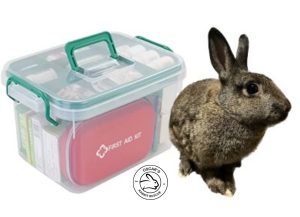Establish with a rabbit savvy vet as soon as you bring a rabbit home. It is important to establish this relationship and take your rabbit to the vet for annual check-ups and when concerns arise. Also, the RHDV-2 vaccine is an initial 2-dose series, then needed annually.
Rabbit-Savvy Vets – Click Here
Medical Concerns: Click here
How to Tell if Your Rabbit is Sick: Click here
GI Stasis, The Silent Killer: Read more here
GI Stasis is common and important to understand and prevent!
Recognizing pain symptoms: Read more here
Rabbits are prey animals, so they hide signs of pain very well.
RHDV-2 Vaccine Information: Click here
DIY Emergency Rabbit First Aid Kit
A rabbit first aid kit is essential for every bunny owner. This is a list of items we recommend you have on hand as a rabbit first aid kit. Remember to check expiration dates as some items will expire.
We highly recommend getting a sturdy, waterproof container like this to keep these items in so they are easy to find or grab in the case of an emergency or emergency evacuation.
Emergencies that should not wait: Click Here
First Aid Kit Checklist

· Veterinary Contact Info – Information for your rabbit-savvy vet and option(s) for an emergency rabbit-savvy vet. A business card works great, or write it down on paper.
· Gauze Pads, Cotton Balls, & Q-tips – Assortment of bandages and cotton pads for caring for minor wounds or accidents. Gently clean around an effected area with a dabbing motion. Rabbit skin is very fragile. Q-tips can be used for cleaning areas around the eyes and cleaning out scent glands. Any eye injury or concern needs to be seen by a vet ASAP. It is safest to take your rabbit to a vet, even for minor cuts or scratches, because they commonly form into an abscess and become infected.
· Vetrap Bandaging Tape (Buy on Amazon) – This is a self-sticking bandage often used by vets to secure bandages on animals that will not cause painful fur loss when removed.
· Tweezers (Buy on Amazon) – To remove a lodged splinter.
· Rounded Tip Scissors (Buy on Amazon) – To cut bandages and tape.
· Hand Sanitizer & Disposable Gloves (Buy on Amazon) – To prevent the transfer of germs. Washing your hands with soap & water is ideal, but if not available have hand sanitizer available.
· Vetericyn Wound & Skin Care (Buy on Amazon) – An antibacterial spray that is safe for rabbits, good to use to clean scrapes and cuts.
You can also use hydrogen peroxide and dilute it with water. Add 1 part hydrogen peroxide to 20 parts water and mix the solution. (e.g., ¼ cup of hydrogen peroxide added to 5 cups of water). Apply with cotton pads or a spray bottle.
· Saline Solution (Buy on Amazon) – Good to have on hand for washing out your rabbit’s eyes if they get debris or gunk stuck in them. You can use an over-the-counter saline solution that is used for contact lenses as long as it is a simple solution without any medication. You can also find pet-specific eyewashes, such as the Vetericyn eyewash.
If you notice gunk forming in or around your rabbit’s eyes often, take your rabbit to the vet. This could be a sign of clogged tear ducts or teeth problems in your rabbit.
· Eye Dropper (Buy on Amazon) – To have on hand in case your rabbit has an eye irritation. It can be used to gently flush out a foreign object or gunk from the eye.
· Neosporin (Buy on Amazon) – Antibiotic cream to apply to a cut or scrape. Make sure it does not have “pain relief” ingredients in it. Use a small dab and cover it with a bandage to prevent your rabbit from licking and ingesting it.
· Nail Clippers (Buy on Amazon) – These are to have on hand to regularly trim your rabbit’s nails which is important to help prevent toe injuries. These are easy to misplace, so having them with your emergency kit is a great place to store them!
· Styptic Powder (Buy on Amazon) – If you accidentally clip your rabbit’s nails too close, they will bleed (same if they get their nail caught and rip it off). Dip the nail in styptic powder to stop the bleeding. This is for use on the nails only.
· Oral Syringes – If your rabbit stops eating or drinking, you’ll need these to administer food and water to help prevent GI Stasis. Get 1 cc size for medication (Buy on Amazon) 35 cc size for feeding (Buy on Amazon). This must be done very carefully to prevent aspiration.
· Oxbow Critical Care (Buy on Amazon) – This is one of the most important things to have on hand in the event of an emergency. This supplement is useful to syringe feed your rabbit if they stop eating. The flavor is tasty and it will get them the nutrients you need. Just mix with water. This does not take place of a vet. WARNING: Force feeding Critical Care when there is a blockage (GI stasis) can cause worsening of the blockage. A vet needs to rule out obstruction with x-ray, and providing pain medication is crucial. PREVENTING GI STASIS IS CRITICAL: Understand GI Stasis Here
· Infant Gas Drops (simethicone) (Buy on Amazon) – Rabbits have a sensitive digestive system and can suffer from gas build-up. GI Stasis can be caused by gas build up in the stomach that prevents your rabbit from eating. When they stop eating, the GI tract quickly slows down and a blockage forms resulting in deadly GI Stasis.
If you notice your rabbit is sitting uncomfortably, pressing their belly onto the floor, they may be suffering from gas. Try to give them 1 mL of the simethicone formula every hour for 4 hours and safely place your rabbit on a heating pad. If there is no improvement after this time, and your rabbit has not been eating or pooping for the past 10 to 12 hours, then you should treat it as an emergency situation and get your rabbit to the vet immediately.
· Applesauce – Handy to have in case needed to help administer medications or to get a stubborn bunny to eat Critical Care. *Avoid sugar*
· Heating Pad (Buy on Amazon or Amazon) – Must have as it can be a potential life saver! When rabbits get stressed, their body temperature falls, making it more difficult for their body to function properly. On these occasions, it is necessary to externally heat up your rabbit using a heating pad.
Use your heating pad on a low setting and always make sure it is wrapped with a towel/fleece. Never place it directly against your rabbit. Place it near your rabbit. Make sure your rabbit is able to move away from the heating pad if they want to.
You can use a heating pad to help your rabbit stay warm if they have gone into shock, are recovering from surgery, are suffering from hypothermia, or if they have GI stasis. This should only be a temporary solution to help your rabbit while you get them to a qualified rabbit-savvy veterinarian.
· A&D Ointment (Buy on Amazon) – Sold in stores as a diaper rash ointment, A&D is often recommended by vets to treat hock sores on rabbits. If you have Bag Balm on hand, this can also be used. Prevent ingestion and take your rabbit to a vet if there is no immediate improvement to prevent major injection that can spread to the bones. This is also a painful condition, so pain medication from the vet will likely be needed.
· Infant Gas Medication (Buy on Amazon) – GI Stasis can be caused by gas build up in the stomach that prevents your rabbit from eating. You can give your rabbit 1 cc of infant gas medicine (simethicone) every hour for three hours to try and relieve the build up. Make sure to follow up with a vet if you rabbit doesn’t start eating normally again.
· Papaya Tablets (Buy on Amazon) – If your rabbit is prone to hairballs, giving a papaya tablet weekly can help keep their system moving.
· Rectal Thermometer (Buy on Amazon) – Because a rabbit’s body temperature can be elevated by stress (like a car ride to the vet), it’s good to be able to take the temperature at home to have an accurate number for your vet. A rectal temperature is the only accurate reading with rabbits.
Apply Vaseline or 100% petroleum jelly to use as a lube for the thermometer prior to insertion to help your rabbit feel more comfortable through the procedure. Normal range: 101.5 ºF to 103.5 ºF.
· Vaseline (Buy on Amazon) – To lubricate the thermometer. See above.
· Cooling Pad – To cool an overheating rabbit. You can use a pet cooling pad, piece of tile, or an ice pack wrapped in blankets or a towel. Frozen water bottles could even be considered a safer option because if the rabbit decides to chew on them, it’s only water on the inside.
· Brushes and flea comb – You may want to keep your rabbit’s grooming items together with your first aid kit to keep them from getting misplaced. Rabbits may be picky with brushes, so whatever works best for you. Here are a couple of my favorites: Hair Buster Comb and Slicker Brush (with plastic tipped bristles). Have a flea comb on hand in case your rabbit contracts fleas.
For those with long hair rabbits, regularly groom to prevent matting, as mats can be painful for your rabbit. A Pet Mat Remover may be helpful to have in case a mat does form, but be very careful with your rabbit’s delicate skin. If unsure/not experienced with this, consult a rabbit experienced groomer.
· Towel – It’s important to have a large bath towel on hand that you can wrap your rabbit in a bunny burrito if you need to restrain them. It can be used to keep your rabbit warm. It works well in their carrier when taking them to the vet.
· Carrier (Buy on Amazon) – Must always have a carrier ready to use to take your rabbit to the vet or evacuate a building. I like this carrier with a top door for easier access to get a rabbit in and out, especially in an emergency. When choosing what size carrier, make sure that your rabbit has space to turn around completely in it, but not much more to help avoid injury while in a moving vehicle. Make sure it is made of solid materials because rabbits like to chew, has good ventilation, and is easy to clean and carry.
This carrier is another nice option. Taking your rabbit to the vet is a stressful experience. One of the worst parts is to get them out of the carrier. This carrier was designed to help ease the stress of going to the vet and getting your pet out of the carrier.
Additional Resources:
Bringing Home a Pet Rabbit
